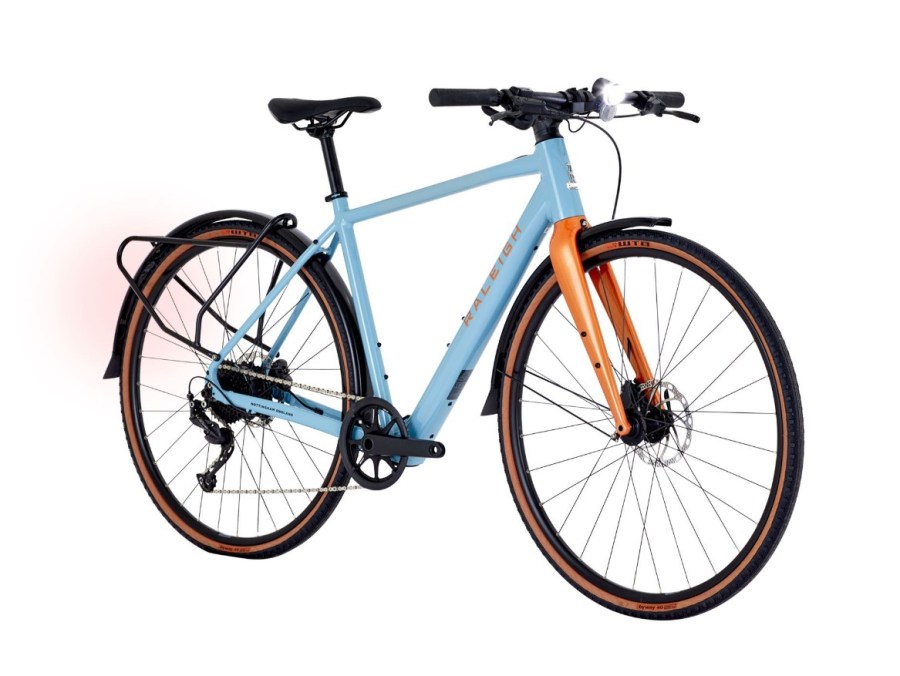Raleigh Trace e-Bike review: A modern machine from this historic British brand that’s perfect for city riding…
Raleigh Trace e-Bike
BUY IT NOW:
£2,199, raleigh.co.uk (not yet available in the US)
tweekscycles.com / tredz.co.uk
Pros:
- Simple to use
- 3 distinct power levels
- Impressive battery life
- Quality components
Cons:
- Power mode can be difficult to see in bright daylight
- Little information on frame measurements
Many might think Raleigh is one of those heritage cycle brands that have had their heyday. It’s true that the 130-year-old Nottingham-based firm doesn’t have quite the same profile it once had. And quality British bike manufacturers such as Boardman and Genesis have since come to the fore. But it still produces a range of good quality albeit largely uninspiring hybrid bikes. It has, however, also joined the electric bike revolution. And on the evidence of the Trace, this is an area it seems to excel in. See how it stacks up against the other best electric bikes.
As well as a number of e-cargo and folding e-bikes, the Trace is the standout bike in its electric range. True, it is another hybrid, but this one has a touch of panache about it. Available in a striking copper colour, or a more understated sky blue (with a fetching orange fork and logo), it’s a nine-speed machine with lightweight 6061 aluminium frame (which some high-end mountain bike frames are made from), and a tapered carbon fork.
Raleigh Trace features
Rigid front and rear mudguards and rear pannier rack come as standard, as do powerful automatic lights fore and aft. A Shimano Alivio 9-speed groupset takes care of shifting duties, while a 250Wh battery and Ebikemotion X35 rear hub motor provide the power. Altogether it’s a nifty machine that weights in at 36.4lb / 16.5kg. If it lost the mudguards, rack mounts and flat bar, the Trace could easily become a drop-bar speedster.
Much of the enjoyment of riding the Trace lies in its simplicity of operation. There’s no screen with which to select drive modes; instead there’s a single large button on the top tube. This illuminates to tell you which mode you’re in: green for low, orange for medium and red for high. It also switches on the lights.

Although in bright daylight it can be difficult to see which mode you’re in, as it only blinks for a few seconds, the difference in power between the three modes is quite noticeable. As you cycle through the modes from low to high, the next press of the button switches the power off. Riding the Trace with the power off feels like the equivalent of engine braking. It’s as if the brakes have been lightly applied or there’s some kind of resistance. So unlike bikes like the Canyon Roadlite:ON CF 9 Ltd, the Trace isn’t a great one to ride unassisted.
Raleigh Trace battery
Again unlike the Canyon, you can’t take the battery out of the Trace (either to charge it or to ride it like a regular bike). So it feels that this is an electric bike that’s designed to be ‘always on’. That said, it has an impressive 50 mile / 80km maximum range on its lowest setting so a full charge will see you through all but the longest return commuting journeys. It will also power well over half a day’s leisurely riding.
Of course being able to take the battery out to top it up on longer journeys would be ideal. But even then charging time is stated as 4 hours so even eking out another 20km would take an hour’s charge. So for me that came to define the use of the Raleigh Trace. Though it can be pedalled unassisted, it feels less able than a regular bike like this, and much better with the motor even on its lowest setting. So I’d look at this as an urban e-bike for commuting, shopping and short- to medium-distance hops.
Raleigh Trace sizing
A beefy stem and wide-ish, flat bars create a stable, if a little compact, cockpit. I felt my riding position was a little too low at times. This is by no means a deal-breaker, and can always be sorted out by putting a spacer under the stem. Though the saddle was comfortable even on long city riders I wanted to push it a bit further back than it would go. Again you could always swap out the inline seatpost for a layback one.
Both these slight issue could well stem from the frame size. I had the 46cm (small), which despite having a 55cm top tube felt a bit cramped for room. I’m 5ft 7in / 1m 70cm so often fluctuate between a small and medium. There isn’t much help on the website in terms in of explaining frame measurements (which I often rely to get the right size). However, there is a handy online tool for helping you get generally the right fit. This actually suggested I get the larger frame than the one I had.
Raleigh Trace components
One thing I was particularly Impressed with was the wheels on the Raleigh Trace. Wide Rival rims shod with 700 x 42C ByWAY tan walls tyres ironed out uneven road surfaces and offered plenty of grip. Thru-axle hubs gave plenty of lateral stiffness too.
It’s good to see the use of hydraulic brakes here. They tend to give a little extra bite when braking, which you might not always need on an urban bike – but I’d rather have too much braking power than not enough. The only downside is, although they won’t need servicing very often, when they do you’ll probably need to get a bike shop to do it. Mechanical brakes are easy to service at home with just a hex key.
The integrated lights and mudguards are what make the Trace an all-weather, all-year commuting workhorse. Both lights are large and bright enough to guarantee you’ll be seen, and the front central AXA Compactline 35 light will throw a decent beam in front to pick out potholes or bends along dark country lanes. The mudguards are stiff and robust and won’t rattle around or rub against tyres like some.
Should you buy the Raleigh Trace?
As long as you can get your riding position dialled in on the Raleigh Trace, it’s a real joy to ride. It’s rugged enough to withstand even the roughest road conditions yet light and nimble to control. Powerful brakes can be finessed with one finger to give you confidence-boosting control in busy traffic, while its compact frame makes it agile without feeling twitchy.
The 40mm tyre and carbon fork combo enhance comfort further. Although it copes well on gravel paths and towpaths it’s not a machine for anything rougher. But that unobtrusive top-tube power button helps you forget you’re even riding an e-bike at times. You’ll probably not want to ride it motor-free for very long, but that tends to be true of most e-bikes.
For its reasonable price (it’s currently on sale at £1,700) you get a well-specced, attractive, high performance machine from a brand with real cycling heritage. It’s a worthwhile investment that’s promises years of riding enjoyment.
Related content:







